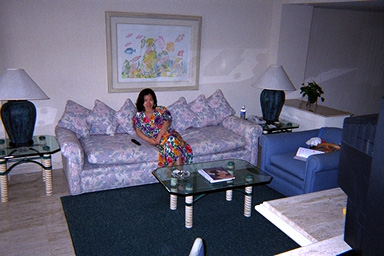 Hsuan in the living room area.
Hsuan in the living room area.Hsuan and I were feeling burned out by our jobs, so during the week of May 2 through May 9, we took a Funjet vacation (ATA was the airline) to Cancún, Mexico. I had been to Canada twice, for work, but despite having lived in California for 11 years and having taken 4 years of Spanish in high school, I had never been to Mexico. It seemed like a nice and affordable delayed-one-year-anniversary getaway.
The trip from Chicago was easy and uneventful. When we got to Cancún, it was instantly apparent that area was entirely dedicated to serving almost entirely American tourists. US English and US currency were not a problem, and people live for tips there. The tourist part of Cancún is a large sand bar, several miles long, with a lagoon on one side and the Caribbean on the other side. The tourist area is densely populated by hotels (ranging from economy to luxury), restaurants (including large American chains like Planet Hollywood and Hard Rock Cafe), sports bars, regular bars, and shopping. ("Authentic Mexican experience" this was not, but easy Caribbean vacation it definitely was.) Cancún is located on the Yucatan peninsula. The weather is sunny, warm (or hot), and humid (or very humid).
By the way, the hotel tap water and restaurant water in the tourist area of Cancún is safe for tourists, because it's all treated. Elsewhere, bring bottled water. The food that we had in Cancún -- Mexican and otherwise -- was uniformly excellent.
We were met at the airport by representatives of the Lomas Travel agency, the local Funjet affiliate, and we were efficiently brought to our hotel, the Fiesta Americana Coral Beach. José, the guy who checked us in, somehow managed to upgrade us to a very nice master suite at the price of the regular room (junior suite? the hotel is all-suites) we were expecting. After we checked in, we met Alberto Zepeda, the Lomas representative, who discussed our tour/excursion options, and we arranged and paid for a number of tours through him. More about those below.
Because we were to be in Mexico during May 5th, Hsuan asked about whether
there would be special Cinco de Mayo celebrations. Alberto and other nearby
travel agency representatives looked amused and sort of smirked. They explained,
"We don't celebrate that here. They celebrate that only in the States.
In commemorates a battle where some Mexicans beat the French, but it's no
big deal here." They were right: May 5th came and went, and nothing
happened.
 Hsuan in the living room area.
Hsuan in the living room area.
 Hsuan in the bedroom area.
Hsuan in the bedroom area.
 The view of one of the swimming pools, the beach,
and the other side of the hotel from our balcony. Our balcony was like one
of those large ledge-balconies facing the ocean on the other side, rather
than one of those tiny, recessed balconies. It's late afternoon. (This photo
brightness-enhanced.)
The view of one of the swimming pools, the beach,
and the other side of the hotel from our balcony. Our balcony was like one
of those large ledge-balconies facing the ocean on the other side, rather
than one of those tiny, recessed balconies. It's late afternoon. (This photo
brightness-enhanced.)
We were very lucky to get a huge suite. Basically, it had not only a raised bedroom area and a separate living room area, but it also had a huge bathroom, a separate jacuzzi, and a big big BIG balcony overlooking the beach and pool area (instead of those tiny, railed balconies that other rooms get). The floors and the bathroom were marble.
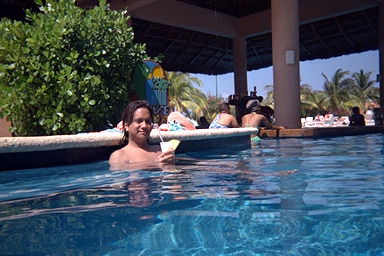 Me, at one of the bars in one of the three swimming
pools. Yes, I'm growing my hair long.
Me, at one of the bars in one of the three swimming
pools. Yes, I'm growing my hair long.
There were three heated swimming pools, all connected by a series of "waterfalls" and equipped with poolside bars, a grill, and a restaurant. None of the pool areas were more than about four and a half feet deep, so the drunkards won't drown.
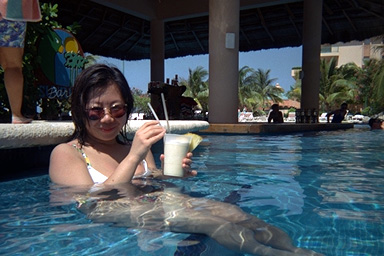 Hsuan -- same bar, same pool, same drink.
Hsuan -- same bar, same pool, same drink.
The beaches in Cancún (the tourist area) were fenced off between hotels. At our hotel, security guards kept watch on the beach to make sure that people who weren't guests of the hotel didn't stray onto "our" beach. You could rent jet-skis and other watersports equipment, and every once in a while, a hotel staffer would go around the beach with a bullhorn, trying to get people to play beach volleyball -- with the winning team getting free beers. During our first few days, the beach was populated by college kids and early-twentysomethings, with lots of flirting, but later, it was populated by more middle-aged people, discussing things like insurance
We hung around the beach and pool on Sunday. On Monday, we took a day trip to the great Mayan ruins at Chichén Itzá. This was the first tour we arranged with Alberto Zepeda and Lomas Travel. We left in the early morning on a fully air-conditioned bus for the 2-3 hour trip from Cancún to the ruins. Our tours guides were Gerardo ("Jerry") and a woman whose name I forgot. On our way there, Gerardo spoke about the Yucatan peninsula - its flora, fauna, and the kinds of peppers grown there. The woman served drinks and snacks from a very large cooler. The bus driver drove the bus. (Tips -- individually or to the group -- seem to be customary at the end of the day.)
(As an astrophysicist, I noticed that Gerardo constantly misdescribed the difference between solstices and equinoxes, but I think I was the only person on the tour to notice.)
Mayan history isn't a specialty of mine, and the tourist info I have, the guide book, and various web sites I've checked seem to have either conflicting or incomplete information. Chichén Itzá was a Mayan capital, religious, and cultural center. I've read that it was first constructed around 520 AD, but it may have been originally constructed by pre-Mayan people. I'm not sure exactly when it was abandoned, but like other Mayan sites, it was probably abandoned around or even centuries before the arrival of Europeans. The Mayans were victims of their own apparently self-fulfilling prophecies predicting the end or changes to their civilizations. Gerardo explained that, like other Mayan cities, it was not only abandoned but also dismantled, and it has been rebuilt by archaeologists. Chichén Itzá is the most complete and largest reconstruction.
We arrived at the ruins a little before noon -- along with a zillion other tourists. The place is basically set up as a big tourist park, with souvenir shops, outdoor snack bars, restrooms, and an air-conditioned auditorium near the entrance gate. Tour groups were all over the place.
 A solar observatory. (Unretouched.)
A solar observatory. (Unretouched.)
 A ball court, as seen from the inside.
A ball court, as seen from the inside.
Since I'm neither a tour guide nor an anthropologist specializing in ancient Mayan culture, there's no point in my showing all the pictures of all the buildings we saw. Go read a book for that, or better yet, visit Chichén Itzá yourself. As with any Central American civilization, you might expect a solar observatory, temples, and some sports arenas. Gerardo explained that the Mayan ball game was a combination of soccer, basketball, and some other things, and it was the captain of the winning team who had the honor of having his head cut off -- so he could have a conversation with the gods (Kukulkán, Chaac, and the others).
The main attraction at Chichén Itzá is the temple pyramid, El Castillo. During sunset (or sunrise? I forgot) on the vernal equinox, sunlight and shadows play a trick on the pyramid such that the steps on the north side are illuminated and appear as a giant snake stretching from the top of the pyramid to the ground -- a powerful fertility symbol. (Kukulkan, the chief god and god of fertility, sometimes appeared as a man and sometimes as a winged serpent.)
Naturally, we didn't get to see that visual effect, but Gerardo demonstrated some of the acoustical effects that the Mayans built into the city. If you stand in the middle of the ball court and clap your hands once over your head, the echos bounce back and forth for quite a while. (Gerardo claimed a numerically significant 7 echoes, but I counted more.) If you stand in the center of the court north of the pyramid and clap your hands once, the sound travels up the pyramid and bounces back to you -- and the sound is remarkably like the short screech of an eagle or some other bird.
 The great pyramid, El Castillo, as seen from the
north side.
The great pyramid, El Castillo, as seen from the
north side.
 This is what the stairs look like after you reach
the top.
This is what the stairs look like after you reach
the top.
Of course, the real goal of a tourist at Chichén Itzá is to climb the pyramid. The steps are remarkably narrow and incredibly steep. Gerardo demonstrated that the best way to climb the steps is to place your feet sideways on the steps and ascend in a zig-zag. The person in the lower left corner of the photo above is obviously trying to climb the wrong way -- straight up. It's a surprisingly exhausting climb, and Hsuan actually beat me to the top because I got stuck behind some older gentlemen who were having a hard time navigating their way up.
Hsuan's and my legs were sore for days afterward.
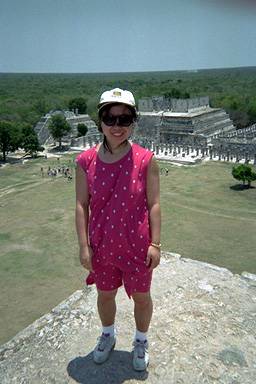 Hsuan, standing on the northeast corner at the top
of El Castillo. That's a temple with Toltec-inspired columns in the background.
Hsuan, standing on the northeast corner at the top
of El Castillo. That's a temple with Toltec-inspired columns in the background.
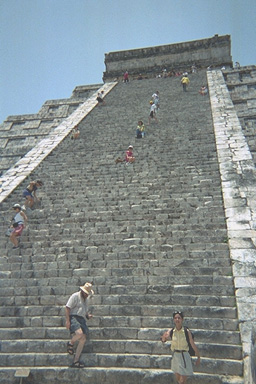 The trip down isn't any easier. That's Hsuan (red
clothing, white hat) sitting and taking a break in the middle . If you look
at the other people, you can get an idea of how steep the stairs are. (In
addition to instant fix, this photo was brightness enhanced and contrast
reduced.)
The trip down isn't any easier. That's Hsuan (red
clothing, white hat) sitting and taking a break in the middle . If you look
at the other people, you can get an idea of how steep the stairs are. (In
addition to instant fix, this photo was brightness enhanced and contrast
reduced.)
After Chichén Itzá, we had a buffet lunch in a local restaurant, where we were entertained by a local dance troupe of kids. The lunch was included as part of the tour. I stopped by a souvenir shop near the restaurant and bought some keychains for some undergrads who were working for me at the U. of Chicago. The keychains were small replicas of the Aztec (not Mayan!) solar calendar.
After lunch, we also visited a large sinkhole. The entire Yucatan peninsula is essentially a limestone shelf, and it is dotted with water-filled sinkholes, many of which are connected by underground rivers going out to the sea. The sinkhole we visited went down maybe twenty to forty meters (I really have no idea) below ground, and at the bottom was a large pool with a barely visible bottom. Tourists were jumping in (from ledges in the sinkhole -- not from the top!) and taking swims.